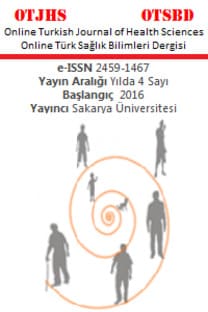Ayırıcı tanıda düşünülmesi gereken akut karın nedeni: primer peritonit
Çalışmamızda karın ağrısı ile başvurup kısa sürede sistemik inflamatuar yanıt gelişen çocuk hastanın tanı ve tedavisini sunduk. Aynı gün başlayan karın ağrısı nedeniyle başvuran 4 yaşındaki kız olgunun batın muayenesi peritonit ile uyumlu idi. Akut faz reaktanları yüksek olan hastanın görüntüleme tetkikleri normaldi. Kısa sürede genel durumu bozulan hastaya geniş spektrumlu antibiyotik ve antiviral tedavi başlandı. Cerrahi ve medikal tedaviye yanıt veren hasta başvurudan 2 hafta sonra taburcu edildi. Akut karın tablosu ile gelen her hastanın ayrıcı tanısında primer peritonitte düşünülmelidir.
Anahtar Kelimeler:
Primer Peritonit, Çocuk, Akut Batın
A cause of acute abdomen that must be taken into account in differential diagnosis: primary peritonitis
In our study, we present the diagnosis and treatment of a child patient with abdominal pain, developing acute systemic inflammatory response. A 4-year-old girl with abdominal pain starting on the same day was compatible with peritonitis in her abdominal examination. Imaging studies of patient were normal, acute phase reactants were high. In the short term, the general condition of the patient was deteriorated and wide spectrum antibiotics and antiviral treatment were started. The patient responded to surgical and medical treatment and was discharged 2 weeks after admission. Primer peritonitis should be considered in the differential diagnosis of each patient with an acute abdomen.
Keywords:
Primary Peritonitis, Child, Acute Abdomen,
___
- 1. Wilcox CM, Dismukes WE. Spontaneous bacterial peritonitis. A review of pathogenesis, diagnosis, and treatment. Medicine (Baltimore) 1987;66(6):447–456
- 2. M.E. Levinson, L.M. Bush, Peritonitis and other intra-abdominal infections, in:G.L. Mandell, J.E. Bennett, R. Dolin (Eds.), Principles and Practice of InfectiousDiseases, Churchill Livingstone, Elsevier, Philadelphia, 2005, pp. 927–951.
- 3. Fowler R. Primary peritonitis: changing aspects 1956-1970. Aust Paediatr J 1971;7(2):73–83
- 4. Muhammad Faisal Khilji. Primary Peritonitis—A Forgotten Entity. Eur J Pediatr Surg Rep 2015;3:27–29.
- 5. West KW. Primary peritonitis. In: O’Neill JA, Roe MI, Grosfeld JL, eds. Pediatric Surgery, 5th ed. St. Louis, MO: Mosby; 1988: 1345–1348
- 6. Larcher VF, Manolaki N, Vegnente A, Vergani D, Mowat AP. Spontaneous bacterial peritonitis in children with chronic liver disease: clinical features and etiologic factors. J Pediatr 1985; 106(6):907–912
- 7. Gorensek MJ, Lebel MH, Nelson JD. Peritonitis in children with nephrotic syndrome. Pediatrics 1988;81(6):849–856
- 8. McDougal WS, Izant RJ Jr, Zollinger RM Jr. Primary peritonitis in infancy and childhood. Ann Surg 1975;181(3):310–313
- 9. Sheckman P, Onderdonk AB, Bartlett JG. Anaerobes in spontaneous peritonitis. [letter]Lancet 1977;2(8050):1223
- 10. Kimber CP,HutsonJM.Primary peritonitis in children. ANZ JSurg. 1996;66:169–170
- 11. Blevrakisa E, Anyfantakis D, Blevrakisc E, Vlachakis I. Primary bacterial peritonitis in a previously healthy adolescent female: A case report. International Journal of Surgery Case Reports 2016; 28: 111–113
- 12. Mark Malotaa, ThomasW. Felbingerb, Reinhard Rupperta, Natascha C.Nüsslera Group A Streptococci: A rare and often misdiagnosed cause of spontaneous bacterial peritonitis in adults. International Journal of Surgery Case Reports 2015 ;6: 251–255
- 13. Westwood DA, RobertsRH, Management of primary group. Astreptococcal peritonitis: asystematic review. Surg Infect(Larchmt). 2013;14(2):171–176.
- 14. Cesar Alaniz, PharmD, and Randolph E. Regal, Spontaneous Bacterial Peritonitis P T. 2009 Apr; 34(4): 204–210 .
- 15. Strauss RM, Dienstag JL. Ascites and its complications. In: Morris PJ, Malt RA eds. Oxford Textbook of Surgery. New York, NY: Oxford University Press; 1994:1265–1271
- 16. Block SL, Adams G, AndersonM. Primary pneumococcal peritonitis complicated by exudative pleural effusion in an adolescent girl. J Pediatr Surg 1998;33(9):1416–1417
- ISSN: 2459-1467
- Yayın Aralığı: Yılda 4 Sayı
- Başlangıç: 2016
- Yayıncı: Oğuz KARABAY
Sayıdaki Diğer Makaleler
Büyük adenomatöz kolorektal poliplerde insan papilloma virüs varlığının araştırılması
Mehmet Ali ERDĞAN, Ali Ramazan BENLİ
Tuğba KOCAHAN, Ebru ARSLANOĞLU, Bihter AKINOĞLU, Çağlar SOYLU, Necmiye ÜN YILDIRIM
Farklı ısınma aktivitelerinin 50 m yüzme performansı üzerine etkisi
Ahmet Emre FAKAZLI, İpek EROĞLU KOLAYİŞ
Nütrisyonel destek yaklaşımında karşılaşılan sorunlar ve çözüm önerileri
Ayırıcı tanıda düşünülmesi gereken akut karın nedeni: primer peritonit
Zeliha AKIŞ YILDIZ, Ceyhan ŞAHİN, Mehmet ARPACIK, Aytekin KAYMAKCI
Tahir KESKİN, Ferdi BAŞKURT, Zeliha BAŞKURT, Tuba İNCE PARPUCU
